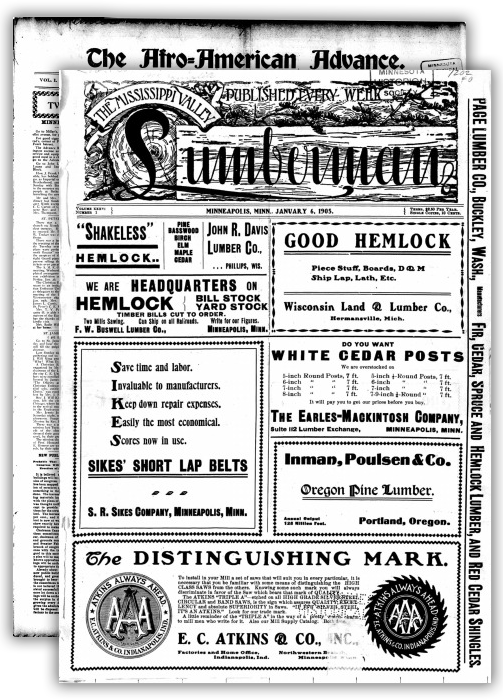
hub
Introduction
titles
About the titles
corporations foundations
Search the Newspapers
hub-faq
F.A.Q.
Choose a Menu
-
hubIntroduction
-
titlesAbout the titles
-
corporations foundationsSearch the Newspapers
-
hub-faqF.A.Q.
Minnesota Farm Review
Minnesota farm review (Minneapolis, Minn.) 1908-1924 Browse the title
The Minnesota Farm Review was published by the Alumni Association of the University of Minnesota, School of Agriculture in St. Paul, Minnesota. Beginning in the mid 1800s people in Minnesota hoped for an official institution that would research agricultural methods and educate farmers. This desire created county and state agricultural societies which eventually evolved into the school of agriculture, which conducted research into more productive farming techniques. The school’s existence in St. Paul coincided with Minnesota becoming the leading state for farming and flour milling in the United States.
The Minnesota Farm Review began as a monthly in January of 1896 and was initially called the Farm Students’ Review. The name was changed to the Minnesota Farm Review in July of 1908. In September of 1916 the paper became a weekly with publication ceasing every summer. It continued to be published until March 1924.
The Minnesota Farm Review was consistently four pages and six columns. The paper was created for members of the "Ag campus," which included alumni, faculty, and students. The geographic focus was limited to the state of Minnesota and the St. Anthony neighborhood in particular, where the agricultural campus was located. The Minnesota Farm Review attempted to function as a paper for the St. Anthony neighborhood, as well as the campus. At times articles related news from outside the state, usually reporting on the travels of campus members.
The editorial team for the paper changed numerous times. Faculty or alumni normally held the position of editor, but the paper was given over completely to student management at certain points. An advisory board of alumni oversaw the publication of the paper. The first weekly issue of the Minnesota Farm Review stated that it wished to become, "the community newspaper of the entire agricultural department of the University of Minnesota." The paper was to be "a weekly review of life on the campus of the university’s department of agriculture and by campus will be understood not only University farm, but the farms and homes of those who have received their education at University Farm."
The paper kept members of the agriculture campus updated on news within the department. As a new school year began it reported on the activities of faculty and students over the summer. Articles about the agricultural industry were also included to connect students to the wider profession. Advertisements in the paper were mostly related to farming. There were ads for cattle breeders, animal feed, tractors, and other farm equipment.
On March 13, 1924, the Minnesota Farm Review published its last issue. The advisory board voted to discontinue publication for two reasons. The paper had suffered financially and was unable to obtain the advertising support needed to cover the cost of printing. The publication also had trouble serving the agriculture school and the college, "two groups which [were] so widely separated in viewpoint." In addition, alumni argued that the paper was serving the St. Anthony neighborhood more than the alumni of the campus. In conclusion the board proposed that two publications take the place of the Minnesota Farm Review, one for the school and one for the college. Beginning in April 1924, the Minnesota Farm Review was replaced by the Gopher Countryman. The new paper was published by the students of the College of Agriculture, Forestry, and Home Economics.
Minnesota Digital Newspaper Hub
The Minnesota Digital Newspaper Hub is a searchable website from the Minnesota Historical Society that makes millions of pages of Minnesota newspapers available online.
The Hub contains geographically and culturally diverse newspapers published between 1849 and today. Due to potential copyright restrictions most issues published after 1977 can only be accessed from the Gale Family Library at the Minnesota History Center.
The Minnesota Digital Newspaper Hub incorporates Minneapolis Tribune titles previously found on a stand-alone website, foreign-language titles, and much more, with new titles and date ranges continuously being added.
The Minnesota Historical Society's newspaper digitization program is made possible through support from the National Endowment for the Humanities and the National Digital Newspaper Program (NDNP), the Legacy Amendment's Arts and Cultural Heritage Fund through the vote of Minnesotans on Nov. 4, 2008, SELCO (Southeastern Libraries Cooperating) through a grant from the Minnesota Arts and Cultural Heritage Fund for Libraries, and many other organizations and individual donors.
Material in the Digital Newspaper Hub may be protected by copyright law (U.S. Code Title 17).
Looking for more information on MNHS digital newspaper collections? Visit Digital Newspapers at MNHS
